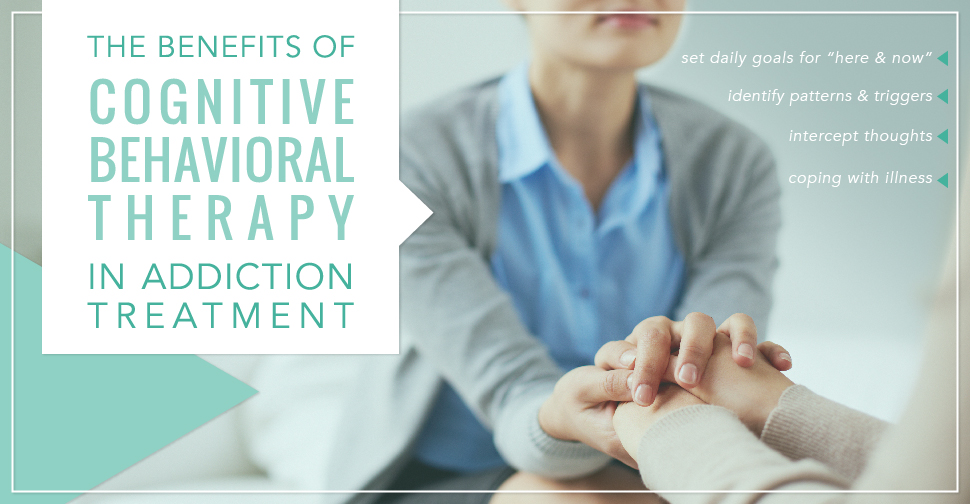What Is Cognitive Behavioral Therapy?
When treating substance dependency effectively, the key to achieving lasting results in overcoming the dependency is identifying the root of the problem. For many, the dependency to drugs or alcohol stems from patterns of deep-rooted negative thoughts or attitudes that manifest themselves as maladaptive behaviors or habits. Cognitive behavioral therapy, also known as CBT, is an intervention method that addresses this cycle and approaches recovery from a psychological standpoint.
According to the Center for Disease Control (CDC), CBT is a technique that has been successful in the treatment of a variety of physical as well as mental health conditions and has also shown results for individuals struggling with addiction. CBT is a method that requires a therapist and an affected individual to work together to set daily goals meant to help cope with the illness through cognitive and behavioral changes. For addiction treatment, what this technique does is assist the individual in pinpointing the core thoughts that are causing them to continually resort to alcohol or drugs. Then, once those deep-rooted harmful thought patterns are identified, the goal is to intercept the process by where those thoughts become destructive maladaptive practices.
As told by experts at the University of Chicago, psychologically, it is necessary to have a healthy foundation of thoughts and beliefs about ourselves so that our everyday actions can reflect them in a healthy way. On the contrary, if we have a harmful or negative set of beliefs about ourselves, CBT offers the scientific approach necessary to be able to identify and combat a cycle where those negative beliefs will turn into self-destructive actions. It is a research-based therapy technique that demonstrates that a person’s negative thoughts, feelings, and beliefs about themselves and their surroundings are oftentimes the source of their problematic behaviors. The idea is that our cognitions will ultimately dictate how we navigate our lives and environment. Thus, it is important to be able to work toward having healthy cognitive processes that will lead to healthy habits.
Triggers
A vital step in the CBT process is to not only identify harmful cognitive patterns but also address the triggers that activate them. A negative emotion, feeling, or predicament can turn on a switch for a person struggling with an addiction–a switch that will prompt the affected individual to turn that negativity into a given action. What researchers of the CBT method have found is that it is necessary to identify and pinpoint exactly what it is that makes that switch turn on for different individuals. This is key because if a therapist and the patient can identify what makes that switch turn on, it will shed light on where there is opportunity to replace the maladaptive habit or action with a positive one, even if it is a seemingly small positive action.
Little by little, after keeping a healthy habit of looking out for triggers and actively intercepting the moment when that negative thought becomes a negative action, the affected individual gradually reaches a point where instead of reinforcing their deeply-rooted harmful thought pattern, they start undoing that pattern and subsequently retrain their brain in the right direction.
CBT aims to have the individual undergoing therapy to be better able to manage the uncomfortable feelings that they have instead of escaping them in ways that will only lead them to reinforce negative thoughts that they already have which will lead the cycle to continue.
Goals
The collaborative nature of this type of treatment is what makes it work. Unlike other types of therapy that may sometimes keep the focus on early childhood or formative years, the focus of CBT is the “here and now.” What is meant by this is that once the problematic thoughts are identified, the therapist and affected individual will actively work to set, meet, and exceed short-term objectives that will change or manage these harmful thoughts.
The goal is to gradually unlearn a way of thinking or a pattern of feelings that are actively causing a series of problematic habits for the individual. In order to move forward with a healthy lifestyle, it will be necessary to unlearn this pattern of negative thinking and retrain the brain, little by little. It’s all about making short-term, feasible, positive cognitive changes that will overall have a long-term lasting impact.
Taking Action
The most important part about the CBT method is that instead of focusing on all the harm that has been done in the past, it invites you to ask, “What can I do right now,” “What can I do today,” and “What can I do tomorrow.” The process is about moving forward, taking the road to recovery one step at a time and working side-by-side to make sure that each step and each action is calculated and coming from a new cognitive approach, no matter how little that step may be. It invites not only the person suffering from the addiction but also everyone who loves them to take action and rest assured that the road to recovery is a good one.
Contact Us
 For more information on getting the best help for you or a loved one suffering from addiction, contact us to DrugRehab.org today. We are here to help you move forward on a path to recovery or be a supportive and helpful voice for others. With information on rehabs, treatments, and therapists across the country, DrugRehab.org is here with everything you need for success.
For more information on getting the best help for you or a loved one suffering from addiction, contact us to DrugRehab.org today. We are here to help you move forward on a path to recovery or be a supportive and helpful voice for others. With information on rehabs, treatments, and therapists across the country, DrugRehab.org is here with everything you need for success.


